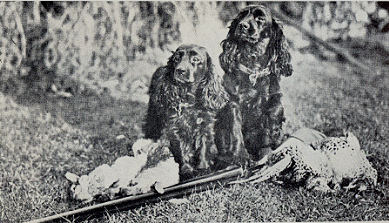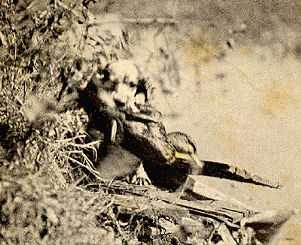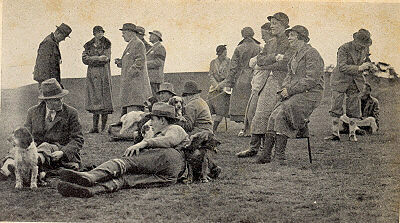 
For thousands of years, spaniel-type dogs have appeared in art and literature, but the distinct spaniel breeds seen today are first apparent around the middle of the 19th century. The recent mapping of the canine genome shows us this in a pattern of breed distinction genetically among sporting dogs. But even as the different spaniel breeds were defined, cockers have always been good gundogs and companions.
Spaniels were used to flush partridges, quail and pheasants into "nets". John Dudley, Duke of Northumberland, father of Robert Dudley, Earl of Leicester, developed netting as a hunting technique. He taught his dogs to sit, or set, "crouching close to the ground for the purpose of allowing the partridge net to be drawn up to and over them. The physician to Queen Elizabeth I, Dr. Johannes Caius, founder of Caius College, Cambridge, documented the technique around 1570. Caius categorized all sporting dogs into two groups: one used to hunt animals and the second for those used to hunt birds. The bird dogs, Auscupatorii, were identified as "index or setter which findeth game on the land," and the "Aquaticus, or spaniel which findeth game on the water."
By 1800, England was the place for hunting spaniels. Still, they were broadly sorted into "land spaniels" and "water spaniels", but by the end of the century the land spaniels were further classified by size or weight. Springers were the largest, field spaniels or cockers, were middle to small, and toys - sometimes referred to as Marlborough Spaniels - were the smallest. Size was determined by the mature dog’s weight - not height and it was common for a puppy from "toy" sized parents to grow to be a "springer".
The most common types found in England between from 1800 to 1840 were the short-faced, red and white Marlborough spaniel and Blenheim spaniel. In the Sportsman’s Cabinet, published in 1803, there is a description of the "springing spaniel" and "cocking spaniel". "The race of dogs passing under the denomination of spaniels are of two kinds, one of which is considerably larger than the other, and reknown by the appellation of the springing spaniel - as applicable to every kind of game in every country; the smaller is called the cocker or cocking-spaniel, as being more adapted to covert and woodcock shooting, to which they are more particularly appropriated and by nature seem designed."
It continues, "From this description the cocker differs, having a shorter, more compact form, a rounder head, shorter nose, ears long (and the longer the more admired), the limbs short and strong, the coat more inclined to curl than the springers, is longer, particularly on the tail, which is generally truncated; colour, liver and white, red, red and white, black and white, all liver colour, and not infrequently black with tanned legs and muzzle."
"These are invariably red and white with very long ears, short noses, and black eyes; they are excellent and indefatigable, being in great estimation with those sportsmen who can become possessed of the breed."
At that time, the springing spaniel and the cocker were different. Because of size, the cocker worked faster, caught scent faster than the springer and were able to get into low busy cover easier than the springer. Both spaniels were used on hare as well as birds and their enthusiasm was seen in their tails. "From the time they are thrown off in the field, as proof of the pleasure they feel in being employed, the tail is in perpetual motion (which is termed feathering), upon the increasing vibration of which the experienced sportsman well knows when he is getting nearer to the object of attraction."
These cocking spaniels weighed between 14 and 20 pounds. The Encyclopedia of Rural Sports (1840) described them as follows: "The cocker, so called from his appropriation to woodcock shooting, has a short, round head when compared with that of a springer; he is, also, much smaller in size, more compact in his frame and not high on his legs. His ears are usually long and well feathered, as are also his legs and tail, his hair likewise generally is more waved and curled than that of the springer spaniel. The cocker of the present day is very diversified in his colour, occasionally he is an entire black and then he is indeed a beautiful animal."
It continues, referring to the Blenheim spaniel, "...they were one and all (red and white) zealous hunters in the field but required much trouble to break," and then comments on a strain of black and white cockers bred by Lord Rivers, "these dogs turned out most excellent in the field and were shot to us with less breaking than any others we ever remember."
In all the early writings, there is no mention of them being used as retrievers. These cockers were used to push out game to the guns.
During the 1850’s and 1860’s, another small spaniel was known as the Welsh or Devonshire Cocker. This dog was used to hunt woodcock for generations in Wales and some speculate were included in cocker pedigrees because they were cobby. These dogs were considered "cockers" until 1903 when they became part of the English springer spaniel registry as Welsh springer spaniels because they tended to be larger, shorter in ear and lacked the ear feathers typical of cockers of the time.
By 1850, breeders began to document pedigrees though often these were oral histories committed to memory. Cockers were in the middle to small group with the larger field spaniels, and the medium sized Sussex spaniels - who were a golden liver color. Anything under 25 pounds was a cocker spaniel. When The Kennel Club of England formed in 1873 with its first Stud Books published in 1874, they attempted to capture information on all litters whelped from 1859 to 1874.
Organizing National Clubs and Field Events
Cocker history is one of the development of a small dog capable of hunting as well as being a good companion. Fashion pushed the pendulum of extremes at different times, but a group of breeders maintained the integrity of the breed related to function and type.
English Champion Obo influenced cockers directly in England and through his descendents in Canada, the United States and Australia. His dam was a black and tan cocker bitch given to Obo’s breeder, James Farrow by sporting friend of his from Norfolk whose family had the breed for many years. Farrow wrote, "...in those days only those [dogs] up to a hard day’s work and sensible specimens were allowed to live, as absolute sporting purposes were about their only enjoyment and dog shows were hardly heard of..."
They were a "hardy lot, gathered from anywhere in the neighborhood for the day’s sport," wrote C.A. Phillips in The Sporting Spaniel (1906) as he described how he remembered rural sportsmen used spaniels in England then.
The Spaniel Club in England was formed in 1885 and immediately they began working on breed standards. These standards would help guide breeders to attain a useful measure of their breeding goals. Before this, spaniels were separated by weight without any reference to other traits that distinguished breeds. Establishing breed standards is challenging with everyone’s personal vision. But the field fancy wanted the spaniels’ working qualities recognized, too.
The Spaniel Club dawdled on setting up field trials to test working ability because they didn’t feel the way in which spaniels worked on estates where the trials were to be held would be functional for competitive trials. The dogs ran in teams and the club didn’t know how these would be judged or how the owners would react to such judging. In the meantime, the Sporting Spaniel Club was formed and started holding field trials with some stakes for braces and teams. They made it work.
The Kennel Club of England recognized cocker spaniels as a breed in 1892, but it wasn’t until 1901 that the weight restrictions were removed as a breed trait. Through the Spaniel Club, Colonel Claude Cane and James Farrow proposed the change which The Kennel Club approved. The Cocker Spaniel Club was established in 1902 and adopted a breed standard based on the one established earlier by the Spaniel Club.
Americans... Born and Bred
While breeders in England were organizing their clubs, Americans and Canadians were as well. In 1881, Clinton Wilmerding and James Watson invited a group of their friends with spaniels, to form what was first known as the American Cocker Spaniel Club, and would later become the American Spaniel Club. A powerful group of wealthy patrons, the American Spaniel Club is the oldest breed club in the United States. A. H. Moore was elected president and club’s first task was to develop breed Standards that would identify field spaniels and cocker spaniels.
The process was tough and took much of the club’s resources for twenty years. Opinions differed and at one point, Arthur E. Rendle made a motion they all be called field spaniels and divide them by weight, light and heavy. It was voted down. He brought it to the table again in 1894 and again was voted down. That was the last time an effort was made to recombine these two breeds.
Still, though recognized as different breeds by the American Kennel Club, it wasn’t until 1905 that cockers and field spaniels were determined to be different enough to warrant their own studbooks.
Many thanks to ASC Curator, Wilma Parker, and ECSCA Secretary, Kate Romanski, for their help with the dates, photos and review of this piece.
Part Two will appear in the May - June issue of Spaniel Journal
References:
|
|
|
| Bookstore | The Bookshelf | Advertise on SJ | Classifieds | Resources | Events | NEW! Point Standings | Letters | Archives | Spaniel Journal | |





